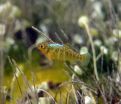(Press-News.org) Chris Martin has bred more than 3,000 hybrid fish in his time as a graduate student in evolution and ecology at UC Davis, a pursuit that has helped him create one of the most comprehensive snapshots of natural selection in the wild and demonstrated a key prediction in evolutionary biology.
"We can see a surprisingly complex snapshot of natural selection driving the evolution of new specialized species," said Martin, who with Professor Peter Wainwright published a paper on the topic in the Jan. 11, 2013, issue of the journal Science.
The "adaptive landscape" is very important for evolutionary biology, but rarely measured, Martin said. He's been fascinated with the concept since high school.
An adaptive landscape takes variable traits in an animal or plant, such as jaw size and shape, spreads them over a surface, and reveals peaks of success (what evolutionary scientists call fitness) where those traits become most effective, or adaptive.
It is a common and powerful idea that influences thinking about evolution. But while the concept is straightforward, it is much harder to map out such a landscape in the wild.
For example, about 50 species of pupfish are found across the Americas. The tiny fish, about an inch or so long, mostly eat algae on rocks and other detritus. Martin has been studying species found only in a few lakes on the island of San Salvador in the Bahamas, where some of the fish have evolved different-shaped jaws that allow them to feed on hard-shelled prey like snails or, in one case, to snatch scales off other fish.
In a paper published in 2011, Martin showed that these San Salvadoran fish are evolving at an explosively faster rate than other pupfish.
Martin brought some of the fish back to the lab at UC Davis and bred hybrids with fish with different types of jaws. He created about 3,000 hybrids in all, which were measured, photographed and tagged. Martin then took about 2,000 of the fish back to San Salvador.
"It was the craziest thing I've done," Martin said. "I was leaning on the stack of them in the middle of Miami airport."
Martin released the young fish into enclosures in the lakes of their grandparents. Three months later, he returned to check on the survivors and plotted them out on the adaptive landscape.
Most of the surviving fish were on an isolated peak adapted to a general style of feeding, with another peak representing fish adapted for eating hard-shelled prey. Competition between the fish had eliminated the fish whose jaws put them in the valleys between those peaks. The scale-eating fish did not survive.
The results explain why most pupfish species in America have pretty much the same diets, Martin said. The generalists are essentially stranded on their peak -- variants that get too far out fall into the valley and die out before they can make it to another peak.
"It's stabilizing selection," he said. An early burst of variation when fish entered a new environment with little competition could have allowed the shell-eaters and scale-eaters to evolve on San Salvador.
INFORMATION:
The work was supported by grants from the National Science Foundation.
A snapshot of pupfish evolution in action
2013-01-11
ELSE PRESS RELEASES FROM THIS DATE:
PLOS Pathogens additional press release -- Jan. 10, 2013
2013-01-11
January 10, 2013
Scientists engineer the Schmallenberg virus genome to understand how to reduce disease caused by the virus.
Researchers from the MRC Centre for Virus Research at the University of Glasgow in Scotland have developed methods to synthesize and change the genome of Schmallenberg virus (SBV). SBV is a recently discovered pathogen of livestock such as cattle, sheep and goats. The researchers have laid bare important ways by which this virus causes disease. The full report about the study publishes on January 10 in the Open Access journal, PLOS Pathogens.
SBV ...
Breath test identifies bacteria's fingerprint
2013-01-11
Scientists have identified the chemical 'fingerprints' given off by specific bacteria when present in the lungs, potentially allowing for a quick and simple breath test to diagnose infections such as tuberculosis.
Publishing their study today, 11 January, in IOP Publishing's Journal of Breath Research, the researchers have successfully distinguished between different types of bacteria, as well as different strains of the same bacteria, in the lungs of mice by analysing the volatile organic compounds (VOCs) present in exhaled breath.
It is hoped that a simple breath ...
Molecular machine could hold key to more efficient manufacturing
2013-01-11
VIDEO:
Professor Leigh’s molecular machine is based on the ribosome. It features a functionalized nanometre-sized ring that moves along a molecular track, picking up building blocks located on the path and...
Click here for more information.
An industrial revolution on a minute scale is taking place in laboratories at The University of Manchester with the development of a highly complex machine that mimics how molecules are made in nature.
The artificial molecular machine developed ...
New nanotech fiber: Robust handling, shocking performance
2013-01-11
VIDEO:
Scientists have created the first pure carbon nanotube fibers that combine many of the best features of highly conductive metal wires, strong carbon fibers and pliable textile thread. In a...
Click here for more information.
Rice University's latest nanotechnology breakthrough was more than 10 years in the making, but it still came with a shock. Scientists from Rice, the Dutch firm Teijin Aramid, the U.S. Air Force and Israel's Technion Institute this week unveiled ...
Study: Model for brain signaling flawed
2013-01-11
A new study out today in the journal Science turns two decades of understanding about how brain cells communicate on its head. The study demonstrates that the tripartite synapse – a model long accepted by the scientific community and one in which multiple cells collaborate to move signals in the central nervous system – does not exist in the adult brain.
"Our findings demonstrate that the tripartite synaptic model is incorrect," said Maiken Nedergaard, M.D., D.M.Sc., lead author of the study and co-director of the University of Rochester Medical Center (URMC) Center ...
Women with pre-eclampsia are at higher risk of complications following childbirth
2013-01-11
Women with pre-eclampsia are at a higher risk of complications following delivery and should continue to be monitored for up to 72 hours, suggests a new review published today (11/01/13) in The Obstetrician and Gynaecologist (TOG).
The review analyses the health risks associated with postnatal hypertension, elevated blood pressure that occurs after childbirth, and looks at the women at risk of this condition and treatments available.
There is extensive literature on hypertension in the antenatal and intrapartum period, but there is little information on postpartum ...
Women should wait at least 12 months before trying for a baby following weight loss surgery
2013-01-11
Women should wait at least 12 months before trying for a baby following weight loss surgery and need further advice and information on reproductive issues, suggests a new evidence-based literature review published today (11/01/13) in The Obstetrician & Gynaecologist (TOG).
The review looks at the safety, advantages and limitations of bariatric surgery and multidisciplinary management of patients before, during and after pregnancy.
With the prevalence of obesity among women of reproductive age expected to rise from 24.2% in 2005 to 28.3% in 2015, the number of women ...
HRT for postmenopausal symptoms can be recommended as an alternative to hormone replacement therapy
2013-01-11
Herbal and complementary medicines could be recommended as an alternative to hormone replacement therapy (HRT) for treating postmenopausal symptoms says a new review published today in The Obstetrician and Gynaecologist (TOG).
The review outlines the advantages and limitations of both pharmacological and herbal and complementary treatments for women with postmenopausal symptoms.
The menopause is defined as the time after a woman's menstrual periods have ceased (12 months after a woman's final menstrual period). It is associated with an estrogen deficiency and can cause ...
New material harvests energy from water vapor
2013-01-11
CAMBRIDGE, MA -- MIT engineers have created a new polymer film that can generate electricity by drawing on a ubiquitous source: water vapor.
The new material changes its shape after absorbing tiny amounts of evaporated water, allowing it to repeatedly curl up and down. Harnessing this continuous motion could drive robotic limbs or generate enough electricity to power micro- and nanoelectronic devices, such as environmental sensors.
"With a sensor powered by a battery, you have to replace it periodically. If you have this device, you can harvest energy from the environment ...
A rock is a clock: Physicist uses matter to tell time
2013-01-11
Ever since he was a kid growing up in Germany, Holger Müller has been asking himself a fundamental question: What is time?
That question has now led Müller, today an associate professor of physics at the University of California, Berkeley, to a fundamentally new way of measuring time.
Taking advantage of the fact that, in nature, matter can be both a particle and a wave, he has discovered a way to tell time by counting the oscillations of a matter wave. A matter wave's frequency is 10 billion times higher than that of visible light.
"A rock is a clock, so to speak," ...


